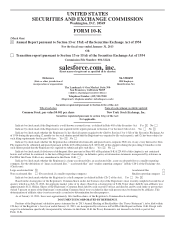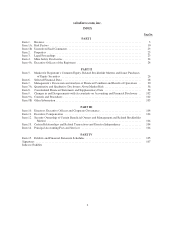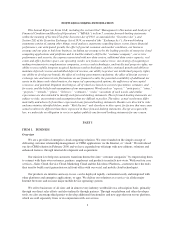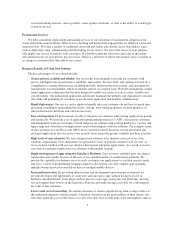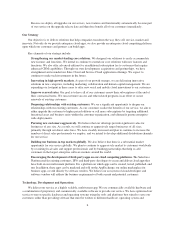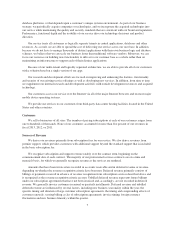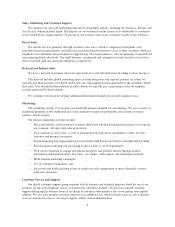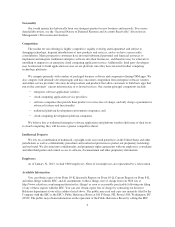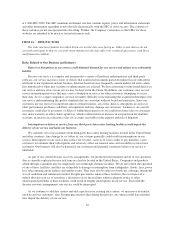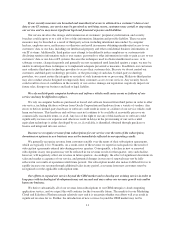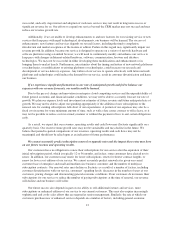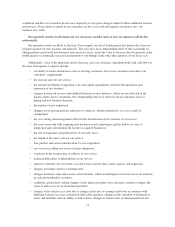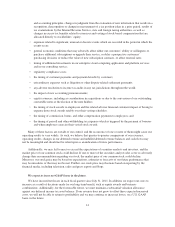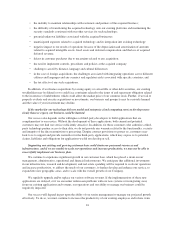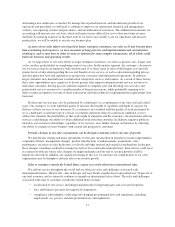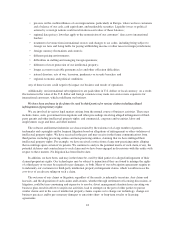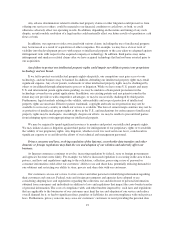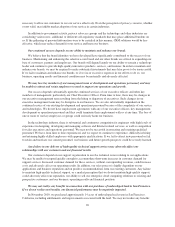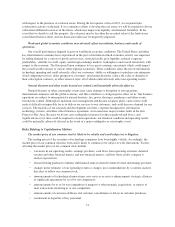Salesforce.com 2013 Annual Report Download - page 15
Download and view the complete annual report
Please find page 15 of the 2013 Salesforce.com annual report below. You can navigate through the pages in the report by either clicking on the pages listed below, or by using the keyword search tool below to find specific information within the annual report.If our security measures are breached and unauthorized access is obtained to a customer’s data or our
data or our IT systems, our service may be perceived as not being secure, customers may curtail or stop using
our service and we may incur significant legal and financial exposure and liabilities.
Our service involves the storage and transmission of customers’ proprietary information, and security
breaches could expose us to a risk of loss of this information, litigation and possible liability. These security
measures may be breached as a result of third-party action, including intentional misconduct by computer
hackers, employee error, malfeasance or otherwise and result in someone obtaining unauthorized access to our
customers’ data or our data, including our intellectual property and other confidential business information, or
our IT systems. Additionally, third parties may attempt to fraudulently induce employees or customers into
disclosing sensitive information such as user names, passwords or other information in order to gain access to our
customers’ data or our data or IT systems. Because the techniques used to obtain unauthorized access, or to
sabotage systems, change frequently and generally are not recognized until launched against a target, we may be
unable to anticipate these techniques or to implement adequate preventative measures. In addition, our customers
may authorize third-party technology providers to access their customer data. Because we do not control our
customers and third-party technology providers, or the processing of such data by third-party technology
providers, we cannot ensure the integrity or security of such transmissions or processing. Malicious third-parties
may also conduct attacks designed to temporarily deny customers access to our services. Any security breach
could result in a loss of confidence in the security of our service, damage our reputation, negatively impact our
future sales, disrupt our business and lead to legal liability.
We rely on third-party computer hardware and software which could cause errors or failures of our
service and may be difficult to replace.
We rely on computer hardware purchased or leased and software licensed from third parties in order to offer
our service, including database software from Oracle Corporation and hardware from a variety of vendors. Any
errors or defects in third-party hardware or software could result in errors or a failure of our service which could
harm our business. This hardware and software may not continue to be available at reasonable prices or on
commercially reasonable terms, or at all. Any loss of the right to use any of this hardware or software could
significantly increase our expenses and otherwise result in delays in the provisioning of our service until
equivalent technology is either developed by us, or, if available, is identified, obtained through purchase or
license and integrated into our service.
Because we recognize revenue from subscriptions for our service over the term of the subscription,
downturns or upturns in new business may not be immediately reflected in our operating results.
We generally recognize revenue from customers ratably over the terms of their subscription agreements,
which are typically 12 to 36 months. As a result, most of the revenue we report in each quarter is the result of
subscription agreements entered into during previous quarters. Consequently, a decline in new or renewed
subscriptions in any one quarter may not be reflected in our revenue results for that quarter. Any such decline,
however, will negatively affect our revenue in future quarters. Accordingly, the effect of significant downturns in
sales and market acceptance of our service, and potential changes in our rate of renewals may not be fully
reflected in our results of operations until future periods. Our subscription model also makes it difficult for us to
rapidly increase our revenue through additional sales in any period, as revenue from new customers must be
recognized over the applicable subscription term.
Our efforts to expand our service beyond the CRM market and to develop our existing service in order to
keep pace with technological developments may not succeed and may reduce our revenue growth rate and/or
harm our business.
We derive substantially all of our revenue from subscriptions to our CRM enterprise cloud computing
application service, and we expect this will continue for the foreseeable future. The markets for our Marketing
Cloud and Salesforce Platform remain relatively new and it is uncertain whether our efforts will ever result in
significant revenue for us. Further, the introduction of new services beyond the CRM market may not be
11


